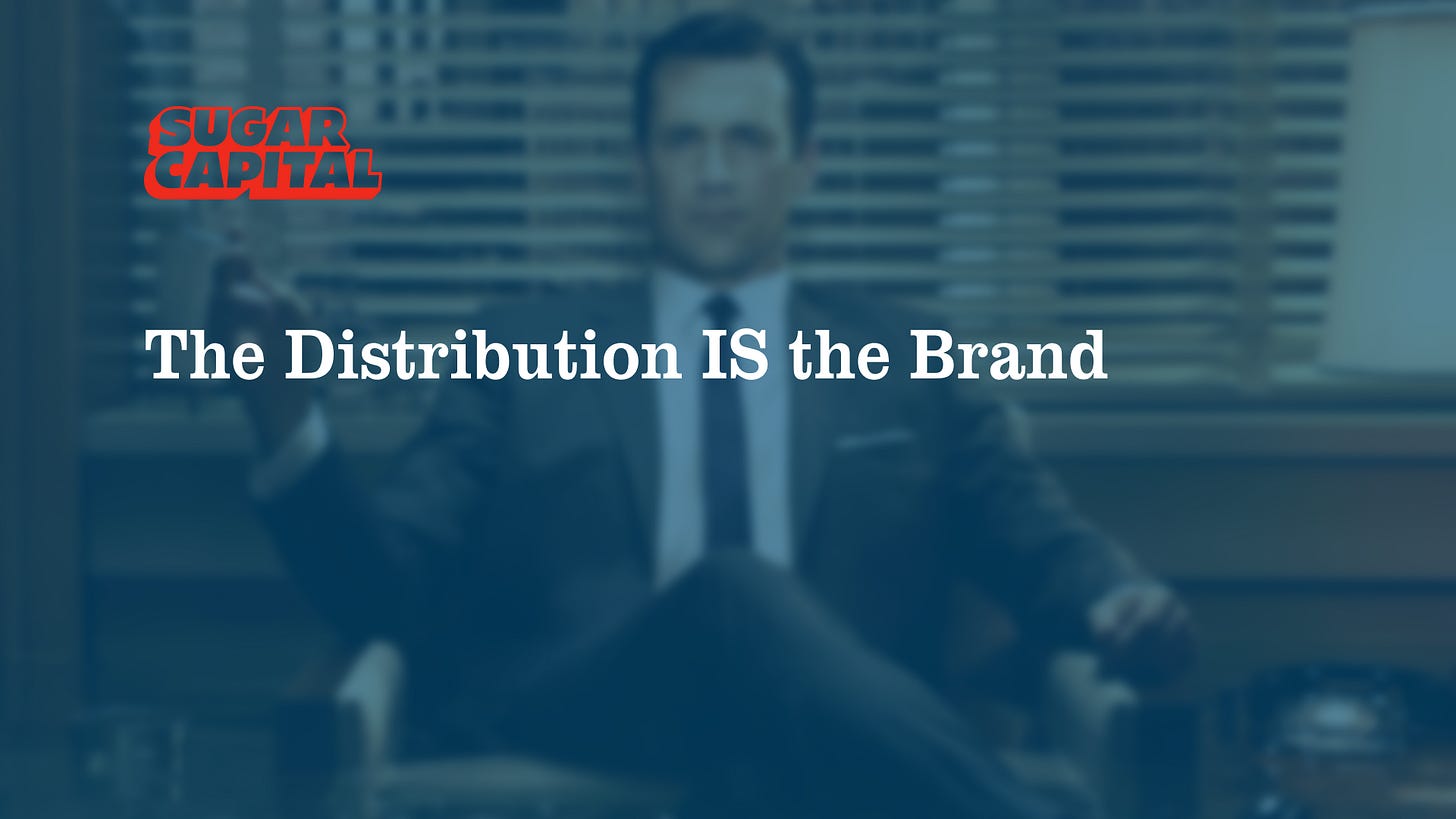The Distribution IS the Brand
From P&G's soap operas to MrBeast's empire: Why the next Nike won't sell shoes
“The product is good. But it's not about the product.” — Don Draper, Mad Men
The question arrived this week: "Can you name a brand created in the last five years that has soul?"
The sender, a portfolio founder wrestling with storytelling in the TikTok era, was onto something profound. To understand the answer, we must first understand that the history of great brands is actually the history of distribution revolutions.
The Medium Creates the Brand
McLuhan proclaimed "the medium is the message," but even he couldn't have foreseen how literally true this would become. Every iconic brand in history was shaped—no, created—by the distribution channel that birthed it. The medium didn't just carry the message; the medium determined what kind of brand could exist at all.
Procter & Gamble didn't advertise on soap operas: they invented them. "As The World Turns" ran for almost 60 years. "The Guiding Light" lasted 72 years, embedding Tide and Ivory so deeply into household routines that three generations couldn't imagine laundry without them. The serialized narrative, the daily ritual—this medium created brand memory that lasted lifetimes.
The soap opera was the product. The soap just paid the bills.
Television amplified this effect. When you could reach 80% of American households with three primetime spots, brands became mythologies. Coca-Cola teaching the world to sing. Marlboro Man defining masculinity. The medium's scarcity created the economics for patient brand building. You could afford to tell stories because you knew the audience would return tomorrow.
From Malls to Algorithms
Then came the mall. From 1970 to 1990, America built 30,000 shopping centers, creating retail as theater. But more importantly, spending hours in a mall created lifetime memories. The cologne fog of Abercrombie, the pink-striped bags of Victoria's Secret—these sensory bombs imprinted on teenage brains.
Your store wasn't selling clothes; it was selling membership in a tribe. The mall wasn't just where brands were sold; it was the medium that created them. Physical distribution became brand differentiation.
The internet's first wave collapsed brand identity into price and reviews. Amazon reduced brands to SKUs on a spreadsheet. On Amazon, efficiency was the brand—and Amazon itself became the only brand that mattered.
Social media inverted everything again. Instagram turned products into lifestyle statements. Warby Parker, Everlane, Allbirds understood that social media wasn't a channel for advertising but a medium for building movements. The product was almost secondary to the story.
By 2018, rising Facebook costs forced brands to trade story for spreadsheets, optimizing CAC over community. It worked until it didn't. When iOS privacy changes killed targeting and costs rose 40% year-over-year, the entire model collapsed.
The TikTok Paradox
Just as TV's scarcity created brand patience, TikTok's abundance creates brand amnesia.
The most powerful distribution medium ever created builds nothing lasting. Sixty billion views for #TikTokMadeMeBuyIt, 700% sales spikes that vanish in weeks, 35% of Gen Z buyers unable to remember what they purchased. Average TikTok ad recall sits below 10%. Eight seconds of attention, zero seconds of memory.
TikTok doesn't build brands, it builds moments—and moments don't compound.
But if P&G invented soap operas, and Nike invented sports storytelling, then today's creators are inventing their own genres in real time. We're not witnessing the death of brand building but the birth of a new distribution paradigm.
The New Playbook
Liquid Death understood this. They built a heavy metal universe first—the world became the distribution. Fourteen million followers don't follow water; they follow entertainment. The water just pays the bills.
MrBeast created the MrBeast universe—extreme challenges, impossible giveaways. Feastables aren't "creator products"; they're artifacts from that universe. The candy bars carry the gravity of his world.
This is why most creator brands fail. Rhode rides Hailey Bieber's celebrity. Kylie Lip Kits earned $600M but couldn't buy lasting relevance. They had moments, not movements. Moments don't compound.
Contrast with Skims, which built a world of inclusive shapewear—every shade, every size. Or Glossier from Into The Gloss, a world that existed before products.
Create the world. The world becomes the distribution. The brand emerges from that world.
While everyone else pays more for less attention, brands that build worlds will own the next century. The medium becomes the moat.
The Investment Thesis
The math is stark. DTC funds betting on Facebook arbitrage are returning pennies—Casper lost $157 per mattress. But funds that understand we're investing in distribution innovations will generate returns that make software multiples look quaint.
In consumer, distribution monopolies multiply value twentyfold.
The brands being built now won't look like brands at first. They'll look like media companies, communities, movements. They'll measure success in audience ownership, not CAC.
The Prize
The next P&G won't make soap. It will make the next soap opera. The next Nike won't sell shoes but membership in a movement.
The question is whether investors recognize we're in a distribution revolution. For those who do, it's the chance to fund companies that will define how humanity connects with products for the next fifty years.
The next great consumer company won't advertise through distribution; it will invent distribution. That is the paradox—and the prize.



Very interesting post. How do you see AI changing this, as creation gets disrupted.. the implication of what you say is that.. brand value will become commoditized since AI will create it eliminating it as a moat. So a P&G of the AI universe will create soap operas but be quickly subsumed by ten other similar brands that just do the same thing.